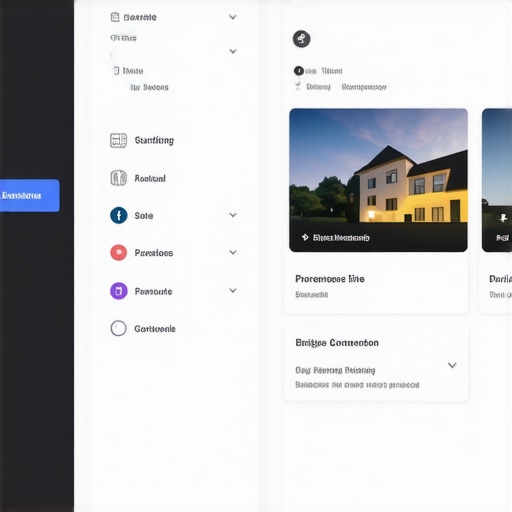
Signal Repair & GMB Cleanup for Better Local Rankings in 2024
My Personal Journey: From Confusion to Clarity with Signal Repair & GMB Cleanup
As someone who’s been dabbling in local SEO for years, I remember the frustration of seeing my Google My Business (GMB) listing stuck in the shadows despite my best efforts. That was until I discovered the power of signal repair and GMB cleanup strategies. In 2024, I finally cracked the code, and I want to share my experience to help others navigate this complex landscape.
Understanding the Magic of Signal Repair in Local Rankings
When I first heard about signal repair, I thought it was just another SEO buzzword. But after diving deeper, I realized it’s about fixing the foundational signals that Google uses to rank your local listing. These signals include consistency in NAP (Name, Address, Phone Number), review quality, and local citations. Improving these signals gave my listing a noticeable boost, especially in the coveted local map pack.
My GMB Cleanup Routine: Clearing the Clutter for Better Visibility
One of the biggest game-changers was my GMB cleanup. I meticulously removed outdated information, spammy reviews, and duplicate listings. This process, which I learned from trusted sources like GMB Exorcist, made my profile more trustworthy in Google’s eyes. The result? Higher rankings and more local calls.
Why Consistency Matters More Than Ever
During my journey, I came to appreciate the importance of consistency. Ensuring my business details matched across all directories and review sites was crucial. This not only improved my local search visibility but also built trust with potential customers who relied on accurate information. I learned that signal repair isn’t a one-time fix but an ongoing process that sustains rankings.
What are the common pitfalls to avoid during GMB cleanup and signal repair?
From my experience, the biggest pitfalls include neglecting review management, ignoring duplicate listings, and failing to update outdated information promptly. Regular audits and proactive management are essential to prevent these issues from undermining your local SEO efforts. For deeper insights, I recommend checking out this comprehensive guide.
If you’ve faced similar challenges or found unique strategies, I’d love to hear your story. Drop a comment below and let’s grow our local rankings together!
Unraveling the Nuances of Signal Repair: What Are the Hidden Factors?
While many focus on visible signals like reviews and NAP consistency, experienced SEO practitioners know that subtle factors such as engagement metrics, photo updates, and category accuracy play a pivotal role in local rankings. These lesser-known signals often get overlooked but can significantly influence your GMB visibility. For instance, regularly updating your business photos not only enhances user trust but also signals activity to Google, potentially boosting your local pack presence. To deepen your understanding, explore this expert guide on comprehensive signal repair techniques.
Can GMB Cleanup Be a Game-Changer for Competitive Markets?
Absolutely. In highly competitive local markets, a meticulous cleanup can set your business apart. Removing duplicate listings, outdated info, and spammy reviews cleanses your profile, making it more trustworthy in Google’s eyes. But the real art lies in maintaining this cleanliness over time. Regular audits, proactive review management, and vigilant information updates ensure your listing remains optimized. For practical tips, check out this resource on sustained cleanup strategies.
Visualize your optimized GMB profile with an engaging, professional photo that highlights your business’s unique selling points. A compelling image can significantly enhance local engagement and trust.
How Do You Maintain Signal Integrity Amid Evolving Google Algorithms?
Staying ahead requires continuous monitoring and adaptation. Google’s algorithm updates often shift how signals are weighted. To keep your local SEO efforts effective, implement a routine of regular profile audits, review management, and citation consistency checks. Tools like BrightLocal or Moz Local can assist in this ongoing process. Remember, consistent effort and staying informed about algorithm changes—by following reputable sources like GMB Exorcist—are essential for long-term success.
If you’ve experimented with innovative signal repair techniques or have insights into maintaining local rankings, share your experience in the comments. For more expert strategies, consider exploring this detailed guide to keep your local SEO game strong.
Deepening My Understanding: The Subtle Art of Signal Optimization
As I continued refining my local SEO strategies, I realized that signal repair isn’t just about fixing obvious issues; it’s about understanding the nuanced interplay of various signals that influence Google’s rankings. For example, engagement metrics like click-through rates and user interaction signals can subtly boost your visibility, especially when your core signals are solid. I discovered that updating photos regularly and adding relevant categories can send positive signals to Google, which many overlook but are crucial in competitive markets.
What Are the Hidden Signals That Could Make or Break Your Local Rankings?
One aspect I’ve explored deeply is the significance of behavioral signals—how users interact with your profile and how Google interprets this activity. For instance, high bounce rates or low engagement can send negative signals, undermining your efforts. Conversely, encouraging reviews, responding promptly, and maintaining active posting can create a positive feedback loop. According to the insights shared by GMB Exorcist, mastering these subtle signals can elevate your local pack presence significantly.
How Do I Sustain My Gains Amid Evolving Algorithms?
Staying ahead requires ongoing vigilance. I’ve adopted a routine of monthly audits, tracking not only reviews and citations but also engagement metrics like photo views and message responses. Tools such as BrightLocal have been invaluable for this continuous process. I’ve learned that adapting to algorithm changes isn’t just reactive but proactive—anticipating shifts and adjusting signals accordingly. For example, Google’s recent emphasis on user experience signals underscores the importance of maintaining a fresh, active profile that reflects real-time updates.
Have You Ever Experienced a Ranking Drop After a Minor Change?
Absolutely. I once updated my business categories without realizing it would conflict with existing signals, leading to a temporary ranking dip. It was a lesson in the importance of consistency and thorough testing. Sometimes, even small adjustments can have outsized impacts if not aligned with your overall signal profile. That’s why I now approach each change with a comprehensive audit, referencing guides like this detailed resource.
Envisioning the Future: The Next Level of Signal Optimization
Looking ahead, I see a growing role for AI-driven insights that can predict signal fluctuations and suggest proactive adjustments. Integrating sentiment analysis tools to monitor review tone and content could become a game-changer. Moreover, more sophisticated engagement strategies—like personalized messaging or dynamic posts—may further enhance signals. The journey of signal repair is ongoing, and staying curious and adaptable is key to maintaining top local rankings in 2024 and beyond.
If you’ve experimented with advanced signal repair techniques or have insights into maintaining rankings in volatile markets, I invite you to share your experience. Let’s continue this conversation and elevate our local SEO game together!
Decoding the Intricacies of Signal Optimization in Competitive Local Markets
In my quest to refine local SEO tactics, I’ve discovered that the true art lies in understanding and manipulating the nuanced signals that influence Google’s ranking algorithm. Beyond the foundational elements like NAP consistency and review quality, subtle factors such as engagement metrics, photo updates, and category accuracy play pivotal roles. These lesser-known signals often serve as the secret weapons that can propel your business ahead of competitors when leveraged correctly. For instance, consistently refreshing your business images not only enhances user trust but also signals activity and vitality to Google, potentially elevating your local pack presence. For those eager to deepen their mastery, I recommend exploring this comprehensive guide on expert signal repair techniques.
Are Behavioral Signals the Hidden Drivers of Local Rankings?
Many overlook the power of behavioral signals—how users interact with your profile and how Google interprets this activity. High bounce rates, low engagement, or stagnant profiles can send negative signals that undermine your efforts. Conversely, encouraging genuine reviews, responding promptly, and maintaining active posting schedules foster positive user interactions, creating a powerful feedback loop that boosts rankings. According to insights from GMB Exorcist, mastering these subtle behavioral signals can significantly elevate your local map pack visibility.
How Do I Sustain and Future-Proof My Local SEO Gains?
Staying ahead in the dynamic landscape of Google algorithms demands ongoing vigilance and adaptation. I’ve adopted a routine of monthly audits, tracking reviews, citations, engagement metrics, and category accuracy. Tools like BrightLocal and Moz Local have been instrumental in maintaining a pulse on my profile’s health. Anticipating shifts—such as the recent emphasis on user experience signals—requires proactive adjustments. For example, Google’s recent algorithm updates prioritize real-time activity and fresh content, so maintaining an active profile with current photos, posts, and reviews is essential. To stay informed, I follow authoritative sources like GMB Exorcist for the latest insights.
What Are the Risks of Neglecting Advanced Signal Optimization?
Neglecting these sophisticated signals can lead to stagnation or decline in rankings, especially in highly competitive markets. For example, failing to update photos or respond to reviews promptly can make your profile appear inactive or untrustworthy, diminishing your local relevance. Moreover, inconsistent or conflicting information across directories can dilute your signal strength, reducing Google’s confidence in your business’s legitimacy. Regularly auditing your profile and integrating advanced strategies—like sentiment analysis or dynamic content updates—can mitigate these risks and ensure your local presence remains robust. For a deep dive into these advanced techniques, explore this expert resource.
Envisioning the Future: AI-Driven Signal Optimization
Looking ahead, I see tremendous potential in AI-powered tools that can predict fluctuations in signal health and suggest targeted improvements. Sentiment analysis, for example, could monitor review content and tone, enabling proactive reputation management. Additionally, dynamic content strategies—such as personalized messaging and real-time updates—may further amplify signals that influence ranking algorithms. This evolving landscape underscores the importance of staying curious, adaptable, and engaged with cutting-edge developments. For those committed to excellence, integrating these innovations could be the key to maintaining a competitive edge well into 2024 and beyond.
If you’ve experimented with these advanced strategies or have insights to share, I encourage you to join the conversation. Your experiences could help others unlock new levels of local SEO success. Let’s collaborate to push the boundaries of what’s possible in local search optimization!
Things I Wish I Knew Earlier (or You Might Find Surprising)
The Power of Consistency
One of the most overlooked aspects of local SEO is how vital consistency truly is. I used to think that just having a good review profile was enough, but I realized that matching NAP details across all platforms makes a huge difference. It’s like giving Google a clear, reliable map to your business.
Small Changes, Big Impacts
Sometimes, minor tweaks like updating your photos or fixing a typo in your address can cause significant ranking shifts. I learned this the hard way when a simple photo update boosted my local pack visibility unexpectedly. It’s these subtle signals that Google loves to see active businesses.
The Hidden Role of Behavioral Signals
Engagement metrics such as click-through rates, response times to reviews, and frequent posting are often underestimated. I discovered that these behavioral signals can sometimes outweigh traditional ones, especially in competitive markets. Keeping your profile lively signals trustworthiness to Google.
Don’t Neglect Reviews
Reviews aren’t just for social proof; they are a core ranking factor. I found that actively managing reviews—responding and encouraging genuine feedback—can significantly elevate your local rankings. It’s about building a community, not just a profile.
The Importance of Regular Audits
Scheduling routine checkups for your GMB profile and citations prevents issues from snowballing. I set monthly reminders to audit my listings, which helped me spot duplications or outdated info early. Staying proactive prevents ranking dips.
Trust the Experts
Over time, I’ve come to rely on trusted resources like GMB Exorcist for cutting-edge strategies. It’s crucial to stay updated because Google’s algorithm evolves constantly.
Resources I’ve Come to Trust Over Time
GMB Exorcist
This site has been my go-to for expert insights on signal repair and cleanup. The detailed guides helped me understand the nuances of local ranking factors and how to address them effectively.
Moz Local
For citation management and monitoring, Moz Local offers reliable tools and advice. It’s like having a health checkup for your local listings.
BrightLocal
BrightLocal’s review tracking and audit tools are invaluable. They helped me keep an eye on my reputation and spot issues before they affected my rankings.
Google’s Official Guidelines
While sometimes dry, Google’s own documentation provides clarity on what they prioritize, especially regarding local search signals. Trusting the source ensures I don’t stray from best practices.
Parting Thoughts from My Perspective
Reflecting on my journey with signal repair and GMB cleanup, I’ve learned that consistent effort and attention to detail are key. Local SEO isn’t a one-and-done task; it’s an ongoing process that requires vigilance and adaptation. In 2024, the most successful local businesses will be those who understand the subtle signals and nurture their online presence diligently. If this resonates with you, I’d love to hear your own experiences and tips. Feel free to share your insights or drop a comment below—let’s grow our local rankings together!





